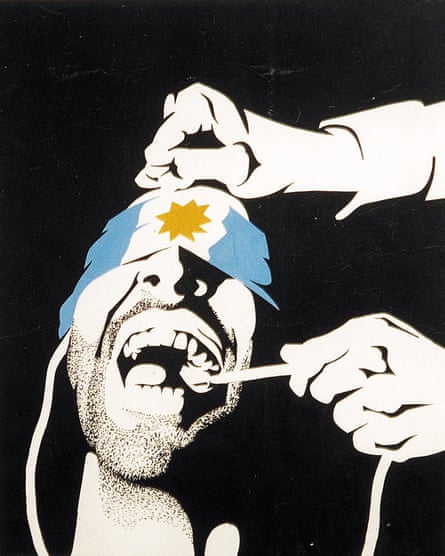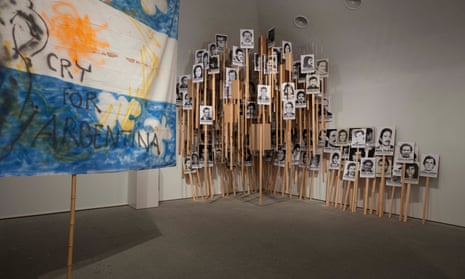Forty-three kites bearing 43 black-and-white faces hang from the ceiling of the Reina Sofía, each one a mute appeal for answers, remembrance and justice.
Close by, T-shirts and posters clamour for equality, a forest of placards commemorates the detained, disappeared and dead of Uruguay’s military dictatorship, and an icon of the struggle for Peruvian independence undergoes a queer, pop art makeover.
The latest exhibition at the Madrid gallery explores how graphic art – whether on walls, posters, prints, flyers or fabric – has been used to confront political repression and demand social justice in Latin America and beyond over the past 50 years.
Called Graphic Turn: Like the Ivy on a Wall, it hopscotches around some of the key sociopolitical moments in recent regional history, examining the responses they elicited on the streets and beyond.

The show is based on research by the Red Conceptualismos del Sur (Southern Conceptualisms Network), which has spent years examining how street art has been used as a tool of creative resistance in Latin America.
While some of the exhibits fizz with rage at dictators, torturers and foreign interference – one poster titled Stop Yankee Attacks on Nicaragua shows an American eagle swooping towards an armed crowd – others derive their power from silence and pain.
A whole room is given over to the 43 student teachers who were disappeared in Mexico in 2014 and whose fate sparked furious protests.
As well as the posters and kites that feature the faces of the missing, there are panels embroidered with messages, some plaintive – “They sowed the seeds of tomorrow’s struggle”, “Your future students are waiting for you in the mountains so they can learn their first letters” – and some angry: “They took them alive, we want them alive” and “No forgiving, no forgetting”.
Another room uses drawings, posters and photos to chronicle the Sandinista revolution in Nicaragua – and chart President Daniel Ortega’s slide into despotism.
“These are posters here that are designed to be stuck on the streets,” said Ana Longoni, one of the coordinators for the Southern Conceptualisms Network.
“But for us what’s also very important is that while these materials, techniques and tools can be used in public spaces, when you put them in a museum, they can also be a very powerful sounding board for what’s happening right now in Latin America and in other parts of the world.”
According to Manuel Borja-Villel, the director of the Reina Sofía, the project is about seeing political graphic art as something that “lives, mutates, and creates a dialogue between its past and its future”.
In the show’s catalogue, he writes: “Like ivy, graphic art grows on walls that are no longer made of stone, and it breaks out again and again. It takes on new forms – which often contain echoes of its previous incarnations – but it never loses its ability to ask questions of us.”
The exhibition also looks into how marginalised and abused people have used graphic art to fight back.
A poster by the Peruvian artist Natalia Iguiñiz, titled My Body Is Not the Battlefield, shows an Indigenous woman silhouetted against a camouflage background and serves as a reminder that thousands of women and girls were raped during the country’s war against terrorist groups in the 1980s and early 1990s. Thousands of Peruvian women – many of them poor, illiterate and indigenous – were also forcibly sterilised under the authoritarian government of Alberto Fujimori in the late 90s.

Another Peruvian piece appears in the show’s In Secret area, which reflects how LGBT groups in Latin America used graphic art to connect and organise in the 70s and 80s.
Javier Vargas Sotomayor’s 2006 work, The Counterfeiting of the Tupamaros, is a response to the murder of eight gay and trans men who were killed by terrorists from the Túpac Amaru Revolutionary Movement in northern Peru in 1989. In it, the artist takes the portrait of the martyred, 18th-century Peruvian independence leader Túpac Amaru II – from whom the terrorists drew their name – and subverts his masculine, martial image by blending his features with those of famous women including Frida Kahlo, Farrah Fawcett and Marilyn Monroe.
Sol Henaro, another of the exhibition’s investigators, likes to see the project as “a series of detonators” rather than something exhaustive, encyclopaedic or linear.
“There’s a poem by a Paraguayan poet, Susy Delgado, called Curuguaty-Ayotzinapa, which is about two very tragic contemporary moments,” she said. “The last bit reads, ‘The same tragic story/repeated a thousand times over/in time’s deaf notebook’. We think this exhibition is about being time’s deaf notebook.”
